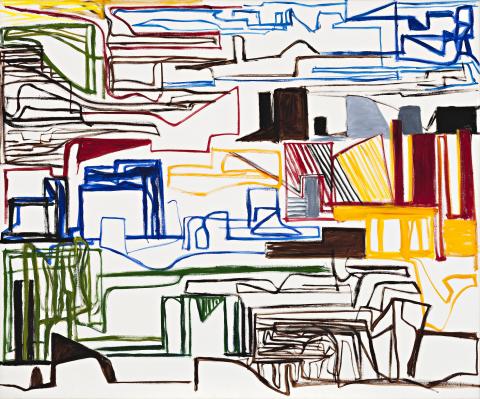LANDSCAPE MARKS NO. 10, 1992
KEN WHISSON
oil on canvas
99.5 x 120.0 cm
signed, dated and inscribed with title verso: Ken Whisson / “Landscape Marks No. 10” / 26/ 6 / 92 & 11/9/92
Watters Gallery, Sydney
The Collection of Colin and Elizabeth Laverty, Sydney, acquired from the above in December 1999
Paintings from the Laverty Collection, Union Club, Sydney, 28 October 2003 – 20 September 2004
Laverty 2, Newcastle Region Art Gallery, New South Wales, 14 May – 14 August 2011
The aesthetic of Ken Whisson is marked by a profound enigmatic quality. Under the guidance of Danila Vassilieff, the artist’s approach to painting grew to be centred on the ability to open oneself to impulsivity and the flow of ideas. Whisson took a particular aversion to conventional technique, preferring to let intuition come freely.
‘I have a distinct impression when working that the painting takes place at the point where the brush touches the canvas, and I believe that art is a result of a direct line of communication between the act of creation and a level of our being which is neither the conscious nor the famous subconscious, but which could be called the intuitive faculty, and which has to function without interference from the conscious thinking process. Our rational and conscious mind looks on and even criticises what is happening, but in the moment of creation, at its fullest realisation, one’s own eyes and mind, one’s own self looking on is caught totally by surprise’.1
Following his move to Perugia, Italy in 1977, Whisson’s work underwent pivotal stylistic changes. The artist’s brushstrokes increasingly wavered between figuration and abstraction. Departing from the blocks of colour common in his earlier works, the artist translated urban and rural landscapes into a series of geometric forms which jostle for prominence; a complex visual language drawn from instinct and memory. The artist’s move to Italy has been described as a self-imposed exile from the Australian art world, yet his work continued to convey memories of his homeland balanced with recollections of his adopted home in Perugia.
Describing no specific place or object, Landscape Marks no. 10, 1992 imperceptibly swings between ambiguity and familiarity, somewhat akin to déjà vu. One senses that they are acquainted with the setting, yet unable to isolate its exact locality. Concepts of foreground and background coalesce – a compelling trait of the artist’s mature works – as though the viewer is ‘studying a diagram of the thinking mind’.2 Whisson’s world is deconstructed and abstracted, trusting himself and the viewer to access and celebrate the processes of imagination. One only needs ‘an openness to experience, a willingness to go beyond appearances’.3
Whisson is represented in numerous major public collections, most comprehensively the National Gallery of Australia which owns over 70 of the artist’s paintings and drawings. As the subject of a major retrospective at Sydney’s Museum of Contemporary Art and the Heide Museum of Modern Art in Melbourne in 2012, Whisson has positioned himself as one of Australia’s great contemporary painters. He has forged an unconventional and highly individualistic path.
1. Whisson, K., 'Talk 1994' reproduced in Ken Whisson: Paintings 1947-1999 with Writings and Talks by the Artist, Niagara Publishing, Melbourne, 2001, p. 143
2. McDonald, J., 'Introduction', cited ibid., p. 9
3. ibid
MELISSA HELLARD
